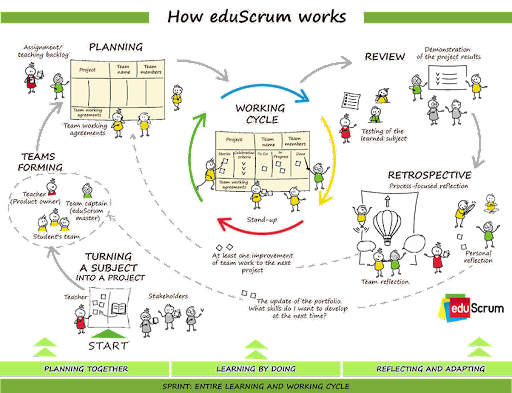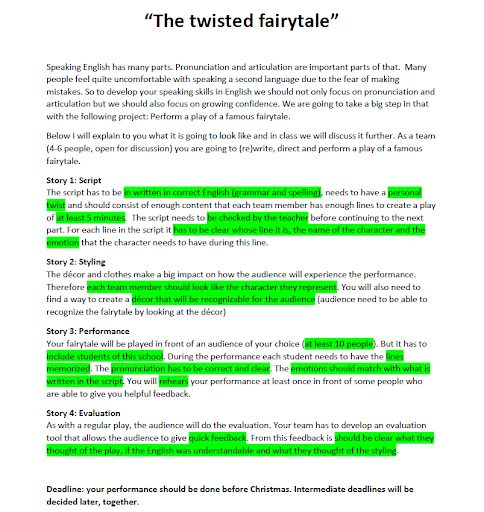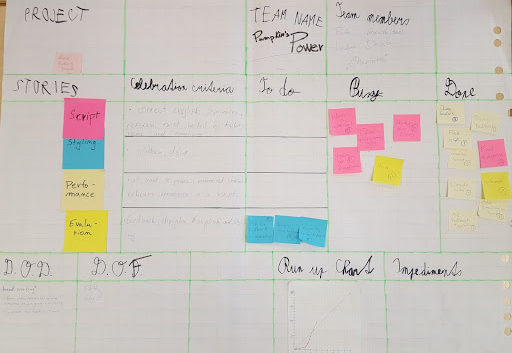About
eduScrum is a framework consisting of tools and ceremonies that allows learners and their coach/mentor/trainer to create, guide, support, plan and evaluate learner-centered learning activities with high quality outcomes from start to finish. The pillars of eduScrum are transparency, adaptation, review and most important trust.
General context
eduScrum started in 2011 in formal education in the Netherlands. Eduscrum is an edit of Scrum that has been effectively used in many businesses over the last two decades and growing rapidly. Right now eduScrum is used in more than 30 countries worldwide in formal and non-formal education. In the Czech Republic, we see that many private schools are interested in eduScrum because they have more freedom in the approaches they use, but it’s starting to be more and more used in the state schools as well. But the most freedom, and therefore the most potential for eduScrum, is in non-formal education in youth work. There is no formal curriculum, and despite that there are pre-defined educational objectives, the learning process is unique to every individual. The learner is really in the center of learning. There is no better way to start a valuable learning activity.
Preparation
Your task is to facilitate the process, so you should prepare and understand the structure you’re giving to the groups, prepare the description of the task and the objectives, if you’re giving the participants any. Make sure the task is related to your objectives and it is manageable for the participants to reach the objectives in the specified time.
Also, you should have a clear idea how to divide your participants in groups.
You should provide materials such as flipchart papers, sticky notes, markers, team making papers and whatever else is needed for the specific project. Most important is that the learners are the ones who are doing most of the work.
Step by step (Instructions)
A full eduScrum training is highly advised and a set of coaching skills are very useful as well. The whole methodology is quite complex and it requires some guidance and practice to manage it as it is proposed. Nevertheless, you can use these instructions to try out a simple eduScrum version in your practice right away.

A summary of the steps required in running an eduScrum project:
- Divide into teams based on skills/qualities or interest depending on the project
- Hand out the project to the teams. Go through the project together to identify the stories and celebration criteria. The complete tasks is split into smaller chunks (stories). Each story has certain celebration criteria. With these criteria we define the quality of the outcome. We describe with these criteria when the work will be considered “good enough”.
- Make a planning using the “to do” list (teams should define and split the concrete tasks they need to fulfill to complete the project), planning poker and the run-up chart. With the planning poker they give each task a certain weight on how much time it will take. The process this in a run-up chart which functions as a live tracker of their progress towards the deadline.
- Actively work on the project
- Regular stand up meetings where students share their progress
- Balance between student-lead time and trainer/coach lead time
- Running a retrospective focusing on the cooperation within the team
- Evaluate the learning outcomes
Reflection & evaluation
Reflection and evaluation are depending on what kind of project is being done and what are your objectives. In all of them, making a distinction between learning outcomes and the cooperation in the team is essential. We propose it is done in several steps:
- You can plan small reflection activities in each check-in meeting, if it makes sense.
- Somewhere in the middle of a project there is an activity called Retrospective. During this activity the teams reflect upon their cooperation. This way, they can still improve the cooperation until the end of their project.
- At the end there is the moment to review the activity. It is still valuable to reflect on the cooperation (mainly since the mid-term Retrospective), but this should be clearly divided from the reflection on their objectives. In the final review, reflection on the working process and objectives makes most sense. How this review looks depends on the project and the context, but we advise to ask questions that are related to the objectives.
Practicalities
Target groups: Groups of all backgrounds and skills can use eduScrum. Minimum age around 10 y.o. (they need to be able to read and write)
Group size: With eduScrum, learners are working in teams. Therefore the minimum group size would be three but a bigger group is preferable giving more options in team composition. There is no limit in numbers.
Time: From start to finish an eduScrum project takes between 10 to 20 hours, depending on your objective. It’s usually spread into several days or weeks.
Materials: flipchart papers, sticky notes, markers
Variations
There are endless variations possible. Based on the skills of the learners and the context the project can be completely coach/trainer/mentor driven or completely student-driven or anything in between. Teams can be put together based on skills or interest or any other way that makes most sense according the context.
Online/digital version
The eduScrum process is easily realized in tools like MIRO where the eduScrum flaps can be made. Together with a communication platform like ZOOM it’s very suitable for online projects. There are several good-practice examples out there. Despite this, it is advised to have at least the beginning, retrospective and review in person, which is much better for the teams’ interaction.
Tips for facilitator/ leader
The foundation of eduScrum is in trust. So the relationship between the learners and the facilitator/leaders is essential. But that counts for every learning environment. Be partners.
Whenever there is an issue, solve it together with the learners if they ask for your help. Make decisions together. Otherwise you can leave them to decide on their own. Even if they make a wrong decision, they will learn from it – and that’s the point.
Each student has a specific set of skills and qualities they can bring to the team. It is up to the team to figure out a way to make sure each member has a valuable contribution to that team. Part of this happens already in forming the teams (based on skills). But it might happen that there is a learner with specific needs. In this case it depends on the facilitator how to deal with it. But if students are not used to having open conversations about special needs, this might be a nice opportunity to open the topic in this team. To have a conversation together and make agreements on how each member can be valuable to the team. According to our experience, in a safe atmosphere, learners will be able to solve this very smoothly.
Suggestions for follow up
For the facilitator/leader there is a possibility (after a completed training by accredited lecturer) to join the international eduScrum community. Once a year there is an international eduScrum gathering and throughout the year there are many possibilities to meet with other eduScrum practitioners.
Also, it is very valuable if you lead eduScrum activities to have basic coaching skills, because it is the best way to guide the learners through the process without influencing them with your ideas. Search for youth workers / teachers coaching approach trainings, if you want to improve.
Example
Context: mix of 8th and 9th class students (13-15 y.o). English seminar (choses subject). State school.
Celebration criteria are highlighted in green.

eduScrum example – description of the task and celebration criteria

eduScrum example – full canvas made by students
Additional resources/ further information
Licences, copyrights
The artifacts of eduScrum are protected by copyright. Only those who had an official training may call themselves a practitioner of eduScrum.
Authors:
This article was written by Mark Postema, an eduScrum trainer and teacher. Revisions made by Lenka Polcerová, ANEV, 2023.






